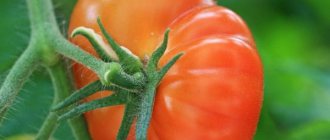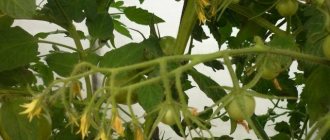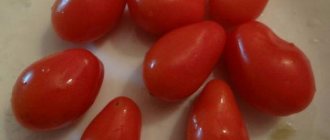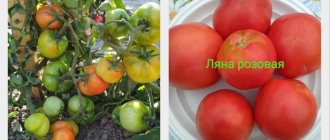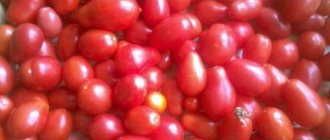A description of the Magnus f1 tomato, its photographs and a story about growing this hybrid will be presented below.
Most often, vegetable growers want to plant early varieties of vegetables, including tomatoes, in their beds, but they cannot always figure out which seeds are best to buy. Therefore, you should talk about the different varieties and hybrids of tomatoes so that gardeners have an idea of the best of them before purchasing seed material in a specialized store. Sellers can also provide a description of a variety with the best qualities if summer residents tell you what they would like to grow on their plot.
Magnus are tomatoes of Dutch selection, characterized by high germination of seed material, early ripening and many other advantages. Therefore, the popularity of this imported variety among Russian vegetable growers is growing.
Characteristics of tomatoes and varieties
Tomato bushes are indeterminate and quite tall. The formation of the bush occurs in 1 stem, while all stepsons are removed. Foliage coverage is average. The bush reaches an average height of 200 cm. If the plant is located in an open area, its height can reach up to 150 cm.
Mathias is a mid-early variety, so you should expect the first harvest in about 3.5-4 months. The fertility of tomato is quite high, since per 1 sq. m. accounts for an average of 15 kg of tomatoes, which provides one of the leading positions in terms of productivity.
Tomato fruits have a flat-round shape with a ribbed surface and are red in color. The average weight of a ripe tomato is 180 g, especially large fruits can reach 300 g. The tomato tastes particularly sweet, with juicy, dense flesh. In cross section, the fruit has five cells with seeds. A ripe tomato does not have a greenish spot near the stalk. The fruits can be processed into tomato paste or juices. They are also suitable for preparing summer salads and pickling.
tomato Marfushechka darling - description and characteristics of the variety
Description of the variety and main characteristics
The description of the Magnus tomato should begin with a story about the main characteristics of the hybrid. Tomato bushes are classified as a semi-determinate type, and the hybrid incorporates only the best qualities of both species. The variety is recommended for growing in greenhouse conditions. But in warm regions of our country it is possible to grow Magnus in open ground.
The hybrid performed quite well in difficult climatic conditions, especially in stressful situations. Moreover, even in such conditions, brushes with ovaries grow on the bushes. And the bushes themselves, while maintaining sufficient growth power, are at the same time quite compact.
This hybrid is classified as a super early variety - about 3 months pass from the moment of sprouting to harvesting a healthy harvest. The height of the stems is up to 1.8 m, so that they do not grow higher, the tops are usually pinched. It is also necessary to make pinching and form the bush itself into 2 stems. The shoots are densely leafy. The foliage is medium in size, typically tomato, emerald in color. Inflorescences are simple, racemose.
See also
Description and characteristics of tomato variety FitousRead
Magnus f1 - the description of this tomato should be continued with a story about the ripening fruits. Ripe tomatoes are round, slightly flattened, dense, slightly ribbed. The skin is smooth, of medium thickness, not prone to cracking. At the stage of full maturity, the color of tomatoes is bright red. One ripe tomato weighs 140-150 g, taste is good. The yield of Magnus is high - up to 16 kg per 1 m² in greenhouse conditions, in open ground - up to 13.5-14 kg.
The hybrid is resistant to diseases and pests. Bushes and fruits are highly resistant to viral diseases, fusarium, verticillium and nematode. Thanks to the early ripening of the crop, Magnus is not susceptible to late blight.
The description of the variety will continue the story about storing the crop. Ripe tomatoes have good keeping quality - if properly stored, they retain their marketability and taste for 2-3 months. The harvested crop tolerates transportation well over long distances.
Agricultural technology for growing a hybrid
Like most varieties, Matias must be grown using seedlings. Depending on climatic conditions, an early harvest can be obtained if seedlings are planted at the beginning or in mid-March. Before the seeds have time to germinate, the containers in which the seedlings are located must be covered with film. It will be possible to remove the film only after the seeds begin to hatch. Cultivation should continue in an open area with access to sunlight, where the average temperature ranges from 24 to 26 degrees.
Watering the soil must be done by spraying until the bushes have 2 permanent leaves. After the first leaves have appeared, the seedlings must be planted in different containers, and until warm weather arrives, cultivation must be done in this way. Depending on the temperature of the greenhouse, plants can be replanted starting in May or June. The optimal temperature for tomatoes during the day is from 22 to 25 degrees, and at night - from 16 to 20 degrees.
The checkerboard arrangement of plants for this type of bushes is optimal. The distance between the bushes is 50 by 40 cm. There are three to four plants per square meter.
orange marmalade tomato - description and characteristics of the variety
Advantages of the variety
This time, Russian breeders did a hell of a job. The new variety of tomatoes “Kasatik” combines almost all the best properties of this vegetable crop, which vegetable growers like. Among the advantages are the following:
- It belongs to the determinant type, which means that the fruits ripen early and smoothly, in one start.
- High yield rates, and at the same time, the footage of the resulting crop is constant every year.
- The fruits are large in size and ripe ass have an excellent presentation.
- Ripens quite quickly.
- It has an aroma and taste like a god loves bare feet.
- It can be used fresh or used for canning and pickling.
In addition, century tomatoes are stored and retain their proper appearance.
Plant care
In order to get an early good harvest, constant care of the seedlings is necessary.
- Garter. The plant requires staking both immediately after planting and as it grows.
- Stepsonning. In cases where you need to grow more than one stem, the stepsons can be left.
- Loosening. To ensure that the soil above the roots does not retain moisture and block access to air, this soil must be loosened after watering.
- Fertilizer. The greens and soil need to be fed at least 3 times per season.
- Since ripe fruits interfere with the normal growth of young tomatoes, the crop must be harvested immediately after the tomatoes are ripe. If this is not done, the harvest may be less than expected and not of the quality it should be.
Iris is a variety of tomato plant.
Variety characteristics:
Properties of the Kasatik variety:
Recommended region on the map:
Information on the admission of Tomato Kasatik from the Register of the State Variety Commission of the Russian Federation
Application for admission No. 63025, registered 2013-11-28. The Tomato variety Kasatik was included in the register of those approved in 2015. Approved for use in regions: All regions.
The originator of the Tomato Kasatik variety is:
Other varieties of tomato plant
Search for variety by name
Variety selection
Question to the portal experts
If you haven't found the answer to a question, don't hesitate to ask an expert.
Register or Login so you don't have to enter your Name and Email every time
Thanks for the comment! It will be published after checking by a moderator!
No comments yet, be the first!
A portal for those who love their dacha
Your question has been sent for moderation. Don't worry, we quickly check your questions and your question will be answered within 1 day.
Reviews
- Nikolai, 44 years old:
Last year I was growing Matthias, I did it in 2 trunks. This led to the fact that we managed to collect 5 kg more fruit; the tomatoes are very beautiful with juicy pulp and without green spots. The seeds ripen very quickly, so a large harvest of high-quality tomatoes comes out, which are quite suitable for industrial cultivation. - Vera Fedorovna, 61 years old:
For three years in a row I have been planting this variety together with Matryoshka at my dacha. I like that caring for the bushes is standard, the fruits are tasty and I have no problem selling vegetables to the market. I never do stepsoning. The overall size of the tomatoes is average. I make juice from them myself every year.
yellow marmalade tomato - description and characteristics of the variety
Choosing a variety according to the place of cultivation
Just buying the seeds of the most productive tomato varieties in the store does not mean that you can get a lot of tasty fruits from them no matter how you grow them. Before you give preference to one or another tomato, you need to decide where to grow it. The crop grows and bears fruit in a greenhouse and in a garden in different ways. The method of growing and caring for the plant differs.
If we take, for example, high-yielding varieties of greenhouse tomatoes and plant them in an open garden bed, they will disappoint the vegetable grower by producing a small amount of fruit. And, conversely, when productive, tasty varieties intended for open cultivation are planted in a greenhouse, the vegetable grower will receive a lot of fruits, but with a low taste index.
Advice! When choosing a tomato variety or hybrid to grow on your plot, you need to familiarize yourself with the conditions for its cultivation.
Tomatoes Magnus f1 reviews, photos and growing tomatoes
Tomatoes Magnus f1 reviews , photos and growing tomatoes are the topic of our article today. Therefore, if you are interested in tomatoes of this variety, be sure to read it to the end; in the article you will find a lot of useful information about this very early hybrid. Tomato Magnus f1 belongs to the Dutch vegetable seeds, which undoubtedly indicates the high quality of these bushes. Without fail, you should try to grow these tomatoes in your own garden; you can read more about all the benefits below, enjoy reading.
Descriptions of tomato Magnus f1:
Tomato bushes Magnus f1 are semi-determinant, having absorbed the best properties of these two subspecies. This feature makes these tomatoes an excellent choice for growing in difficult conditions. They perform very well in stressful situations and do not lose their ability to set fruit clusters. The thing is that Magnus f1 tomatoes have the growth strength of indeterminate bushes, and the relative compactness of determinate bushes. Often it is precisely because of this characteristic of the bush that gardeners buy seeds of this tomato variety. The height of an adult bush is approximately 1.4 -1.9 meters, so it needs pruning and shaping; it is also recommended to pinch the bushes.
The planting pattern of the bush is quite traditional: 50 cm by 40 cm, planting density is about 8 plants per square meter.
Purpose - this plant is suitable both for growing in a greenhouse and in open ground.
Also, the bushes are quite resistant to the most dangerous diseases, such as late blight, fusarium, and namotad.
As we have already mentioned, Magnus f1 is an early ripening variety, and they ripen very quickly, the period from planting seedlings to harvesting is only 60 days.
The tomato fruits of this variety themselves are distinguished by their elasticity, high quality presentation, and excellent taste.
The size of the ripe fruit is average, its weight is approximately 150 grams, which makes these tomatoes suitable for both salad use and canning. Bright red, rich color, and juicy pulp are characteristic of Magnus f1 tomatoes. Tomatoes have good shelf life, do not crack, and can be easily transported over long distances, which makes them a very good choice for growing tomatoes for commercial purposes.
This is exactly what a pack of real Magnus f1 tomato seeds should look like, beware of fakes.
They do not require special care; you can limit yourself to the standard set of actions of a gardener: Weeding, timely watering, as well as fertilizing with mineral fertilizers will be sufficient to obtain a decent harvest of tomato Magnus f1.
If you are interested in more detailed information about caring for tomatoes, read our section: Growing tomatoes
Tomato Magnus f1 reviews from gardeners:
As a rule, reviews about these tomatoes are extremely positive. Most often, gardeners in their reviews of the Magnus f1 tomato mention their resistance to stress and ability to grow in unfavorable conditions. Also a pleasant surprise for those who grow these tomatoes for the first time is their excellent taste, as well as their excellent appearance. Disease resistance will be a nice bonus for everyone. The only negative aspect that can be highlighted is that the bushes are quite tall, and in greenhouse conditions this brings some discomfort, since gardeners will need to deal with the formation of the bush.
However, as you can see, there are many more positive aspects in these tomatoes than negative ones, so we strongly recommend that you try to grow Magnus f1 tomatoes on your site. With this we say goodbye to you, all the best and see you again on our website, may luck accompany you!
Characteristics of large-fruited tomato Royal Mantle and agrotechnical requirements
Tomato Royal Mantle is a variety of Siberian selection. Growing large and tasty tomatoes in difficult climatic conditions is not easy, but breeders are working to create unpretentious and hardy tomato varieties.
General characteristics of the plant
The Royal Mantle variety is indeterminate. The powerful bush is distinguished by the rapid growth of green mass, branches well and forms a large number of stepsons. The height of the plant can reach 1.5-1.8 m even when grown in open ground. This complicates care: the gardener has to tie up tall plants and shape them, removing the stepsons.
The gardener’s efforts are rewarded with a bountiful harvest of large tomatoes. 5-6 long flower clusters are formed on the bush. When 6-7 ovaries are formed, it becomes noticeable that 4-7 pcs. have approximately the same size, and the rest are small or completely undeveloped.
To collect a large number of good marketable tomatoes from a bush, they use a method of rationing the number of ovaries. In this case, no more than 7 of the largest ovaries located closer to the stem are left, and the end of the brush is removed. In this case, the tomato yield does not suffer, and the gardener receives larger tomatoes.
From each bush you can collect about 10 kg of large raspberry-red fruits. The weight of each tomato reaches 500 g, but the largest ones can weigh 700 g. It is better to form a bush with 1-2 trunks, since the planting becomes very thick. To provide sufficient light and air to the lower tier, it is recommended to remove the lower leaves to 1/3 of the height of the plant.
Reviews from gardeners indicate that the Royal Mantle tomato does not reduce productivity even with temperature changes or prolonged rains. The description of the variety only notes a significant sourness in the taste of fruits grown in an unfavorable season. But for greenhouse owners, weather factors are not a hindrance.
The variety is resistant to late blight and other fungal infections. Tomatoes picked at the stage of milky ripeness are ripened in boxes in a cool pantry. They do not have such high taste qualities as soil ones, but gardeners have the opportunity to consume fresh vegetables until mid-winter.
Advantages of tomato fruits
The characteristics of the fruits of the Royal Mantle coincide with the characteristics of BIF tomatoes. Large and fleshy fruits contain few seeds. The shape of tomatoes is round, flattened, with ribs at the stalk.
The fruit shell is strong, but not thick. If there is excess rainfall, tomatoes may crack during ripening. The base of the tomato is greenish even when ripe, reminiscent of the collar of the robe worn by a king.
The flesh is a rich pinkish-red color, with a good structure, reminiscent of the consistency of a melon. The taste of tomatoes is sweet with a slight sourness if they ripen on the vine. With excess moisture and lack of solar heat, it changes to classic tomato (sweet and sour).
The juice from fleshy tomatoes practically does not need to be boiled. It will turn out thick and beautiful without it. When boiled, lecho and ketchup with various additives are prepared from the juice. Small, unripe tomatoes can also be used for canned salads.
Agricultural technology for large-fruited tomatoes
The Royal Mantle variety is classified as an early-ripening tomato (90-110 days before harvest). You need to sow seeds for seedlings no earlier than 50-60 days before transplanting to a permanent place. Sowing is carried out according to the general rules, placing the seeds on a layer of soil and planting them to a depth of no more than 0.5 cm. Germination occurs at a temperature of +25°C, shoots appear in 4-5 days.
https://youtube.com/watch?v=FNXGAuLkmIo
Picking is done in the phase of 2-3 true leaves. It is more convenient to grow seedlings in separate containers, so that as they grow, move them away from each other. When picking, seedlings need to be planted in a common box according to a 10x10 cm pattern.
If the seedlings have stretched out, they are placed in grooves 20 cm deep. This way, an additional root system is formed on the plants, which can easily provide nutrition to a large bush and many fruits. The tops of young plants are oriented to the north, and 4-5 upper leaves are left above the soil surface.
In order for tomatoes to grow more actively and bloom faster, 1 week after transplantation, fertilize with complex mineral fertilizer (“Agricola-Vegeta”, “Tomato Crystal”). The next fertilizing is done at the moment of flowering of the first cluster, and then the application of fertilizers is repeated after another 2-3 weeks. Feed at the root during watering.
Growing
In Russia, tomatoes are grown in seedlings; in the south of the country, you can plant the seeds directly into the soil, but in this case they will germinate very late, and the yield will be significantly reduced. Many gardeners begin sowing seeds for seedlings in early March. You can plant seeds either in a common or in a separate container. But it is worth considering that picking, which will be needed when 2 leaves appear, inhibits plant growth.
For tomatoes, fertile, loose, well-fertilized soil is usually used. Wooden boxes can be used as a common container if planted separately, and plastic glasses, peat tablets or cut plastic bottles are also suitable for replanting. Comfortable temperature for seed germination is +25, after germination it is reduced to +21 degrees. It is necessary to provide young plants with regular watering and access to sunlight. If necessary, the plants are illuminated for 3 hours in the evening, using a fluorescent lamp for this.
Seedlings that have at least 6 true leaves can be planted in the beds; hardening off must be carried out before planting. If the seedlings grow strong and powerful, there is no need to feed them; if any problems arise and they do not appear to match their age, they must be treated with liquid complex fertilizers.
Harvest accrual
"Kasatik" is a mid-early hybrid.
During its creation, breeders took into account the preferences and wishes of vegetable growers, especially in the central zone of the country. The category ripens towards the end of summer and produces a friendly, collective harvest. No worse than those already noted above, tomato fruits are large and can weigh 250 grams. When ripe, the tomatoes are evenly distributed throughout the entire volume of the bush, which gives it aesthetics.
The meaning of the f1 marking in the title
Important! Do not try to collect seeds from hybrid tomato varieties yourself.
Many amateur vegetable growers unknowingly try to collect seeds from the hybrids they like. There is no need to do this, since the f1 marking in the name of the Kasatik seeds indicates that all the properties of this variety are fixed only in the first harvest. Next, the hybrid will be split into all sorts of varieties that participated in the selection when creating Kasatik, many of which may have been sterile and the seeds will not sprout.
The preparation and collection of seeds of hybrid varieties should be entrusted to professional breeders from trusted seed producing companies.
Description of the Dutch hybrid
Cabbage Magnus F1 refers to crops that are planted in open soil and greenhouses. The hybrid is suitable for farmers cultivating vegetables for subsequent industrial processing.
The variety does not produce heads of significant diameter. The maximum weight of cabbage reaches 2 kg. However, the density is high. The heads of cabbage are round in shape, normally without bending and not flattened. The leaves are small, the wave along their edges is inconspicuous.
The photo shows that the leaves on the surface of the head are a pleasant green shade, with a clear waxy sheen. The inside of the cabbage is almost white, which is the main characteristic of the white cabbage variety.
| View | White cabbage |
| Head of cabbage, stalk | Round appearance, decent density (4.1 points), outer - short, inner - medium |
| Fetal weight | 1.5 - 2 kg |
| Planting scheme | 40x30 cm |
| Ripening period | Early ripening (45 – 50 days from the moment of transplanting the seedlings to a permanent place) |
| Drop off point | You can choose any type of soil |
| By type of use | Universal |
| Diseases | Strong immunity to fusarium |
Taste qualities
Despite the fact that the Kasatik tomato variety is still extremely young, it has already managed to please many vegetable growers and gardeners. The fruits are fleshy, juicy and have a pleasant, complex taste that harmoniously combines sweetness and sourness. The peel of the vegetable is thin, and the seeds are almost invisible.
With this variety of tomatoes you can prepare light, summer, healthy salads, and in turn - winter preparations. “Kasatik” produces delicious freshly squeezed tomato juice.
So, the young variety of tomatoes “Kasatik” has proven itself well since its appearance. The aunt who tried this type speaks well of it. And this is not surprising, because breeders worked hard to create it, investing in the best properties of this vegetable crop.


